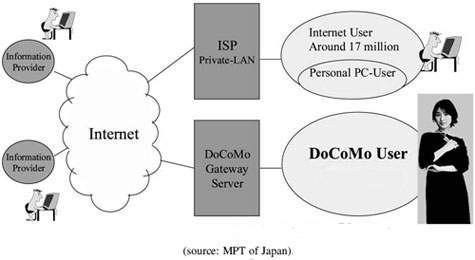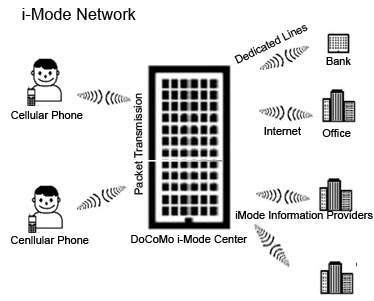
- i-Mode Tutorial
- i-Mode - Home
- i-Mode - Introduction
- i-Mode - Basic Concepts
- i-Mode - Using cHTML
- i-Mode - Network
- i-Mode - Services
- i-Mode - Devices
- i-Mode Useful Resources
- i-Mode - Quick Guide
- i-Mode - Useful Resources
- i-Mode - Discussion
i-Mode - Quick Guide
i-Mode - Introduction
i-Mode, stands for Internet Mode is a microbrowser technology that supports text, graphics, audio, and video for Web access over the Japanese cellular network. It was introduced by a team led by Mari Matsunaga in February 1999 at NTT DoCoMo
Fortune Magazine recently selected Mari Matsunaga as one of the most powerful women in business in Japan.
i-Mode is one of the most successful services offering wireless web browsing and e-mail services from mobile phones in Japan.
i-Mode provides packet-data transmission, which enables operators to charge their customers according to the volume of data transmitted and users do not pay for the time they are connected to a website or service.
Transmission between the handhelds and the i-Mode-enabled cell sites is via packet mode, using packets of 128 octets at high-speed data transmission rates.
i-Mode customer base is increasing exponentially every day in the whole world and is being provided worldwide through DoCoMo's partners through a licensing scheme.
The current i-Mode center is called CiRCUS in DoCoMo's Kawasaki office and the operation support system is called CARNiVAL, which is hosted in the Toranomon JT Building.
There are DoCoMo's competitors in the market who launched very similar mobile data services − KDDI launched EZweb, and J-Phone launched J-Sky etc.
i-Mode History
| Year | Milestone |
|---|---|
| Feb. 1999 | i-mode service launched |
| Dec. 1999 | i-mode compatible handsets with color screens are marketed |
| Jan. 2001 | i-appli service launched |
| Jul. 2001 | i-area service launched |
| Nov. 2001 | i-motion service launched |
| Jun. 2002 | i-shot service launched |
| Jan. 2003 | i-motion mail service launched |
| Jul. 2004 | "Osaifu-Keitai" service launched |
| Sep. 2005 | i-channel service launched |
| Nov. 2005 | "ToruCa" info-capture function offering started |
| Dec. 2005 | "iD" credit card brand launched |
| Apr. 2006 | "DCMX" mobile credit services launched |
| Oct. 2006 | keyword search service for i-mode launched |
i-Mode - Basic Concepts
i-Mode phones have a special i-mode button for the user to access the start menu. There are plenty of official websites, which are linked to DoCoMo's i-mode portal page and DoCoMo's billing services.
i-mode users pay for both sent and received data. There are operators, who are charging their customers with additional charges on a monthly subscription basis for premium services.
NTT DoCoMo takes care of all the contents and operations of all official i-mode sites, most of which are commercial. These official sites are accessed through DoCoMo's i-mode menu, but in many cases, official sites can also be accessed from mobile phones by typing the URL or through the use of QR code (a barcode).
There are essentially four main components that are required for the i-Mode service. They are as follows −
- A cellular phone capable of voice and packet communication and with a browser installed.
- A packet network.
- An i-mode server.
- Information providers.
The following picture depicts a very broad overview of i-mode concept −

i-Mode - Using cHTML
In consideration of the inherently limited bandwidth of the cellular network, i-Mode employs Compact HTML (C-HTML), a simplified version of HTML similar to Wireless Markup Language (WML) used in WAP networks and as well as DoCoMo proprietary protocols ALP (HTTP) and TLP (TCP, UDP).
i-Mode-compatible HTML websites are easy to navigate since all basic operations can be performed using a combination of four buttons, cursor forward, cursor backward, select, and back (return to previous page).
There are functions that require two-dimensional navigation such as image maps and functions that require more intensive processing such as frames and tables are not included in the standard i-Mode HTML specifications.
i-Mode-compatible HTML provides extended tags for special use on cell phones such as the 'tel:' tag, which is used to hyperlink a telephone number and let users initiate a call by clicking on a link.
Following major features of HTML have not been included in i-Mode compatible HTML, i.e., cHTML −
- Background colors and images
- Frames
- Image maps
- JPEG images
- Multiple character fonts and styles
- Style sheets
- Tables
cHTML compliance hardware includes −
Small memory − 128-512Kbytes RAM, and 512K-1Mbytes ROM.
Low power CPU − 1-10 MIPS class CPU for embedded systems.
Small display − 50x30 dots, 100x72 dots, and 150x100 dots.
Restricted colors − mono-color (black and white).
Restricted character fonts − only single font.
Restricted input method − several control buttons and number buttons (0-9).
i-Mode supports 256 color GIF files. In addition, only images in GIF 87, 87a, and 89a formats can be used. The maximum size of a GIF image should be 94 x 72 dots.
The World Wide Web Consortium (www.w3.org) contains a complete listing of the cHTML tags available to developers. Also, you can visit the NTT DoCoMo site at www.nttdocomo/ser2.htm for an outline of cHTML tags available to developers.
There are millions of HTML-based content resources, various software tools, and public materials, which can be used to develop i-Mode applications.
i-Mode - Network Structure
i-Mode Networks utilize two types of computers − servers and clients. Servers are the computers that hold information and they are called DoCoMo i-Mode Centers. Clients are the computers that we view the information and they are cellular i-Mode phone.
The following image shows the i-Mode Network structure diagram −

There are two other important components involved in connecting to a wireless network. In order to connect a cellular network to a server, a gateway must exist. Also, the web site must be in an i-Mode format.
i-Mode Gateway
An i-Mode gateway translates wireless requests from a mobile phone to the server and sends information from a gateway back to the mobile phone.
NTT DoCoMo provides a gateway to their users and connects them to i-Mode enabled websites.
i-Mode Enabled Sites
An i-Mode enabled website utilizes pages that are written in C-HTML. The transmission between the handhelds and the i-Mode-enabled cell sites takes place via packet mode using packets of 128 octets at high speed data transmission rates.
An i-Mode phone utilizes a micro-browser to browse i-Mode enabled site. These phones usually have a title bar with icons at the top of an LCD screen. These icons then allow users to access various services such as weather forecasts, transportation schedules, data searches, news updates, etc.
i-Mode - Services
The highly convenient functions offered by i-mode are enriching our lifestyles by crossing the conventional boundaries of mobile phone functions.
Some of the services that are now available with i-mode include game playing, video viewing and convenient access to the latest news and weather forecasts.
i-appli: i-mode with Java
This service group consists of software (programs) used with i-mode compatible mobile phone terminals. Downloading the software makes it possible to automatically update the news and weather forecast displays as well as to play new games.
i-area: Location Based Service
This is DoCoMo's location information service. The i-area service enables the user to check the weather forecast, traffic and store information, and other convenient information for local areas as well as the map information to the user's current location.
i-motion : Dynamic Video Content
This feature refers to video distribution programs for i-mode mobile phone terminals and the contents. The high-speed packet communication of FOMA entertains users with the latest movie theatre information and details of the sports highlights available in video.
i-motion mail
This service transfers video captured with an i-motion compatible mobile phone via e-mail. It features a transmission speed of up to 15 frames/sec, thus permitting smooth motion video to be enjoyed on a mobile phone.
i-shot : Digital Camera Capability
A function that supports transfer of still images captured with an i-mode compatible phone. The images may also be sent to mobile phones of other carriers and PCs.
i-channel
This service distributes the latest news, weather forecasts, and other information to i-channel compatible i-mode phones. The information is displayed on a standby screen without any special operation and users can access more detailed information by pressing a button.
i-Mode - Devices
There are many cellular phones available in the market that allow i-Mode services. Here is a list of the latest available mobile phones −
- FOMA SA800i
- Fujitsu F905i
- LG KE390i
- LG L343i
- LG L852i (PRADA)
- Mitsubishi M342i
- Motorola RAZR V3xx with i-mode
- Motorola SLVR L6 i-mode
- Motorola SLVR L7 i-mode
- NEC 411i
- NEC N22i
- NEC N343i
- Nokia 6120 classic
- Nokia 6124 classic
- Nokia N95i
- Samsung S400i
- Samsung S500i
- Samsung Z320i
- Sony Ericsson K550im
- Sony Ericsson K610im
With new i-mode services being launched in Europe and Asia, it is timely to learn based on the experiences of Japan what the potential could be.
In the near future, the 4G wireless-equipped i-Mode phone will bring new life to the wireless communications. The wireless mobile Internet is therefore rapidly becoming a reality and the future looks very bright.